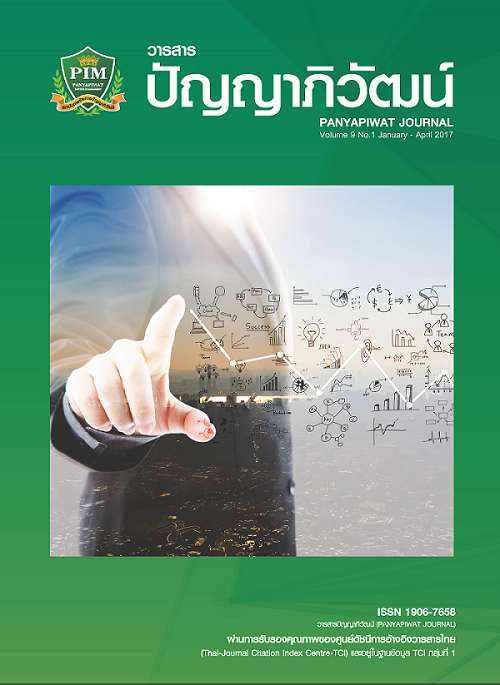การพัฒนาแผนการรักษาพนักงานแบบมีส่วนร่วม
Main Article Content
บทคัดย่อ
การวิจัยนี้มีจุดประสงค์ 1) เพื่อพัฒนาแผนการรักษาพนักงานโดยการมีส่วนร่วมของพนักงานสายงานธุรกิจลูกค้าผู้ประกอบการ และ 2) นำเสนอแผนการรักษาพนักงานที่เกิดจากการมีส่วนร่วมที่ได้พัฒนาขึ้น โดยผู้ให้ข้อมูล คือ พนักงานสายงานธุรกิจลูกค้าผู้ประกอบการรวมจำนวน 20 คน เก็บรวบรวมข้อมูลจากการสัมภาษณ์รายบุคคลจำนวน 13 คน และการสนทนากลุ่ม (Focus Group) จำนวน 7 คน ผลการวิจัยพบว่า บุคลากรมีความเข้าใจในเรื่องของการรักษาพนักงานว่าเป็นสิ่งที่องค์การให้ความสำคัญอย่างมาก และบุคลากรมองว่าปัจจัยในเรื่องของการฝึกอบรมและพัฒนา เรื่องหัวหน้างาน และเรื่องสภาพแวดล้อมในการทำงานเป็นปัจจัยที่ควรมีการพัฒนาให้ดียิ่งขึ้น ผลจากการเก็บและวิเคราะห์ข้อมูลทำให้ได้แนวทางอันเกิดจากการมีส่วนร่วมในการจัดทำเป็นแผนงานจำนวน 3 แผนคือ (1) แผนการปรับเปลี่ยนแผนเส้นทางการเรียนรู้ (Training Roadmap) ให้สอดคล้องกับลักษณะงานของตำแหน่งผู้ดูแลความสัมพันธ์ลูกค้าผู้ประกอบการ (2) แผนการคัดเลือกตำแหน่งผู้นำทีม การพัฒนาและฝึกอบรมทักษะความเป็นผู้นำ และ (3) แผนงานในการสร้างสภาพแวดล้อมในการทำงานที่ดี โดยผลที่ได้มานั้นสะท้อนให้เห็นถึงกระบวนการสร้างการมีส่วนร่วมระหว่างบุคลากรในองค์การอย่างแท้จริง โดยที่บุคลากรมีความคิดเห็นว่าการมีส่วนร่วมนี้จะสามารถทำให้ได้ผลลัพธ์ที่สอดคล้องกับความต้องการของพนักงาน
The objectives of this research are 1) to develop an employee retention plan based on the participation process of the employees in the SMEs business division and 2) to propose the employee retention plan which has been developed. The informants were 20 SMEs business division employees. Thirteen of them had been individually interviewed while 7 employees participated in focus group. The result showed that the employees of SMEs business division understood that employee retention was important to the organization. Furthermore, they were aware that training and development, supervisor and working environment were the essential factors which should be improved. After collecting data and analyzing data, 3 programs were emerged from the participating processes: (1) Training roadmap program which was more relevant with the job characteristic of customer- relationship manager; (2) The selection program of the team leaders, training and development plan for enhancing leadership skills; and (3) The program to build the good working environment. The 3 emerging plan were results of the actual participation processes which the employees agreed that it would meet the needs of the employees.
Article Details
“ข้าพเจ้าและผู้เขียนร่วม (ถ้ามี) ขอรับรองว่า บทความที่เสนอมานี้ยังไม่เคยได้รับการตีพิมพ์และไม่ได้อยู่ระหว่างกระบวนการพิจารณาลงตีพิมพ์ในวารสารหรือแหล่งเผยแพร่อื่นใด ข้าพเจ้าและผู้เขียนร่วมยอมรับหลักเกณฑ์การพิจารณาต้นฉบับ ทั้งยินยอมให้กองบรรณาธิการมีสิทธิ์พิจารณาและตรวจแก้ต้นฉบับได้ตามที่เห็นสมควร พร้อมนี้ขอมอบลิขสิทธิ์บทความที่ได้รับการตีพิมพ์ให้แก่สถาบันการจัดการปัญญาภิวัฒน์หากมีการฟ้องร้องเรื่องการละเมิดลิขสิทธิ์เกี่ยวกับภาพ กราฟ ข้อความส่วนใดส่วนหนึ่งและ/หรือข้อคิดเห็นที่ปรากฏในบทความข้าพเจ้าและผู้เขียนร่วมยินยอมรับผิดชอบแต่เพียงฝ่ายเดียว”
เอกสารอ้างอิง
Braun, V. & Clarke, V. (2006). Using thematic analysis in psychology. Qualitative research in psychology, 3(2), 77-101.
Breen, R. L. (2006). A practical guide to focus-group research. Journal of Geography in Higher Education, 30(3), 463-475.
Buchy, M. & Hoverman, S. (2000). Understanding public participation in forest planning: a review.Forest policy and Economics, 1(1), 15-25.
Chanthawanit, S. (1999). Qualitative Research (8th ed.). Bangkok: Chulalongkorn University. [in Thai]
Chayangkura, C. (2007). Employees retention plan: A case study of Small and Medium Enterprises Development Bank of Thailand. Independent study, Faculty of Political Science, Chulalongkorn University. [in Thai]
Cohen, J. M. & Uphoff, N. T. (1977). Rural development participation: concepts and measures for project design, implementation and evaluation. Monograph Series, Rural Development Committee, Cornell University, (2).
Curry, D., McCarragher, T. & Dellmann-Jenkins, M. (2005). Training, transfer, and turnover: Exploring the relationship among transfer of learning factors and staff retention in child welfare. Children and Youth Services Review, 27(8), 931-948.
Das, B. L. & Baruah, M. (2013). Employee retention: a review of literature. Journal of Business and Management, 14, 8-16.
Hassan, M., Hassan, S., Din Khan, K. U. & Naseem, M. A. (2011). Employee retention as a challenge in leather industry. Global Journal of Human-Social Science Research, 11(2), 8-13.
Kokpol, O. (2009). A Guide Book for Public Participation for Local Governor. Bangkok: S Charoen Printing. [in Thai]
Pantapalangkura, P. (2007). Hiring and Keeping the best people by Peter Cappelli. Bangkok: Expernet. [in Thai]
Rowe, G. & Frewer, L. J. (2000). Public participation methods: A framework for evaluation. Science, technology & human values, 25(1), 3-29.
Roy, B. (2015). A Study on Employee Retention Factors in the Indian Banking Industry–An Empirical Study. International Journal of Advance Research in Computer Science and Management Studies, 3(3), 346-352.
Rudeesarnt, W. (2005). A study of employees’ retention: Comparing between public enterprise and private sector. Independent study, Faculty of Political Science, Chulalongkorn University. [in Thai]
Shaw, R. B. (1997). Trust in Balance: Building Successful Organizations on Results, Integrity, and Concern. San Francisco, CA: Jossey-Bass Publications.
Songsujaritkul, S., Chaiyakit, S. & Santirattagul, P. (2008). Talent Retention: A Case Study of an Executives at True Vision (Public Company Limited). Independent study, Master of Business Administration, Thammasat University. [in Thai]
Sonmanee, K. (2016). Human Resource Management Amid Globalization. Panyapiwat Journal, 8(1), 275-287. [in Thai]
Sriratdeejarus, S. (2006). Development of Women Organization in Wapipathum District through Participatory Process. Master thesis, Master of Arts (Strategies for development), Maha Sarakram Rajabhat University. [in Thai]
Thach, E. C. (2002). The impact of executive coaching and 360 feedback on leadership effectiveness. Leadership & Organization Development Journal, 23(4), 205-214.
Tower Watson. (2014). Global Trends in Employee Attraction, Retention and Engagement. Retrieved Jan 21, 2016, from https://www.towerswatson.com/enGB/Insights/Newsletters/Global/Sustainably-Engaged/2014/global-trends-in-employee-attraction-retention-and-engagement


